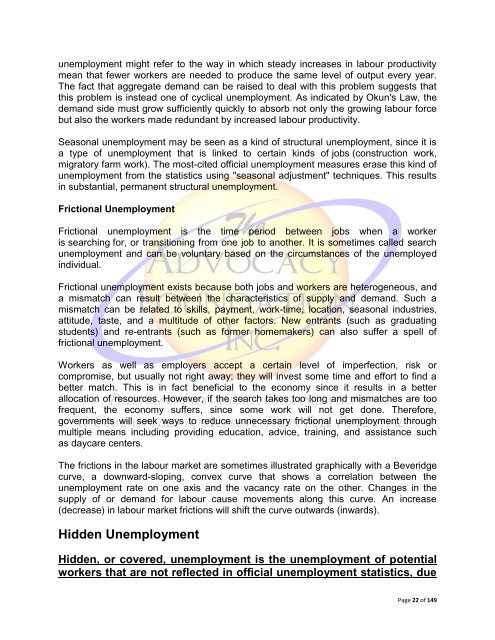Hidden Unemployment
Hidden Unemployment
Hidden Unemployment
You also want an ePaper? Increase the reach of your titles
YUMPU automatically turns print PDFs into web optimized ePapers that Google loves.
unemployment might refer to the way in which steady increases in labour productivity<br />
mean that fewer workers are needed to produce the same level of output every year.<br />
The fact that aggregate demand can be raised to deal with this problem suggests that<br />
this problem is instead one of cyclical unemployment. As indicated by Okun's Law, the<br />
demand side must grow sufficiently quickly to absorb not only the growing labour force<br />
but also the workers made redundant by increased labour productivity.<br />
Seasonal unemployment may be seen as a kind of structural unemployment, since it is<br />
a type of unemployment that is linked to certain kinds of jobs (construction work,<br />
migratory farm work). The most-cited official unemployment measures erase this kind of<br />
unemployment from the statistics using "seasonal adjustment" techniques. This results<br />
in substantial, permanent structural unemployment.<br />
Frictional <strong>Unemployment</strong><br />
Frictional unemployment is the time period between jobs when a worker<br />
is searching for, or transitioning from one job to another. It is sometimes called search<br />
unemployment and can be voluntary based on the circumstances of the unemployed<br />
individual.<br />
Frictional unemployment exists because both jobs and workers are heterogeneous, and<br />
a mismatch can result between the characteristics of supply and demand. Such a<br />
mismatch can be related to skills, payment, work-time, location, seasonal industries,<br />
attitude, taste, and a multitude of other factors. New entrants (such as graduating<br />
students) and re-entrants (such as former homemakers) can also suffer a spell of<br />
frictional unemployment.<br />
Workers as well as employers accept a certain level of imperfection, risk or<br />
compromise, but usually not right away; they will invest some time and effort to find a<br />
better match. This is in fact beneficial to the economy since it results in a better<br />
allocation of resources. However, if the search takes too long and mismatches are too<br />
frequent, the economy suffers, since some work will not get done. Therefore,<br />
governments will seek ways to reduce unnecessary frictional unemployment through<br />
multiple means including providing education, advice, training, and assistance such<br />
as daycare centers.<br />
The frictions in the labour market are sometimes illustrated graphically with a Beveridge<br />
curve, a downward-sloping, convex curve that shows a correlation between the<br />
unemployment rate on one axis and the vacancy rate on the other. Changes in the<br />
supply of or demand for labour cause movements along this curve. An increase<br />
(decrease) in labour market frictions will shift the curve outwards (inwards).<br />
<strong>Hidden</strong> <strong>Unemployment</strong><br />
<strong>Hidden</strong>, or covered, unemployment is the unemployment of potential<br />
workers that are not reflected in official unemployment statistics, due<br />
Page 22 of 149

















